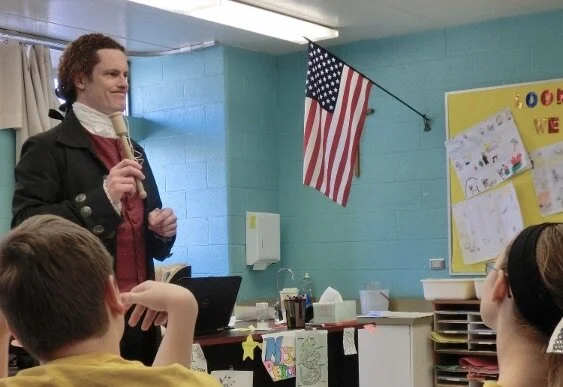Schools and other young audiences
Virtual and in-person audience-participation based shows that are tailored for specific grade, developmental, and age groups: elementary, middle, and high school.
Virtual visits with young audiences at home
In addition to virtual school visits, Mr. Jefferson also visits young audiences and students in their homes by means of Zoom. Mr. Jefferson can visit with your child’s entire class even while they are engaging in at-home study!
High School
Thomas Jefferson welcomes high school students to have fun making meaningful connections between the past and the present.
Younger generations have a great time engaging with past generations when Thomas Jefferson stops in for a visit. (Photo curtesy of Freedoms Foundation at Valley Forge)
Students connect personally with their history in one-to-one conversations with Thomas Jefferson. (Photo curtesy of Freedoms Foundation at Valley Forge)
Thomas Jefferson contrasts James Madison’s and Patrick Henry’s styles of protest.
Thomas Jefferson engages high school students by challenging them with leadership messages, motivating them to improve their communities and the nation by means of their civic participation in government.
Mr. Jefferson talks with, not at, high school students in Independence Hall, inviting them to challenge him when they disagree, and challenging them to change America for the better! (Photo courtesy of Independence National Historical Park)
“The students loved their time with you —you are so inspirational! Steve, you have honed your presentation so well —I wish every student in America could hear it!”
—Cathy Gillespie, Constituting America
Middle School
“I just wanted to thank you immensely for your services last week. Being in the district for over a decade, I don't know of a better speaker that we've had in the past. Knowing that it was towards the end of the school year and the end of the school day, you handled your crowd masterfully.”
—Brian Davis, 7th grade math teacher, Indian Mills Memorial School, New Jersey
Thomas Jefferson enthralls middle school audiences of all sizes! (Photo courtesy of the Richard Nixon Presidential Library and Museum)
Thomas Jefferson uses a mixture of fun and inspiration to communicate America’s core founding ideas and ideals, while also teaching about the writing process behind the Declaration of Independence.
Mr. Jefferson makes history approachable for young audiences. (Photo courtesy of the N-Y Historical Society)
Steve uses Thomas Jefferson’s own metaphors to discuss difficult subjects like slavery. When working with children, he employs props like this stuffed wolf to allow children to engage with challenging subject matter while also having fun.
Elementary School
Jefferson keeps young students giggling and having fun while he enlists the help of student volunteers.
“You did a fantastic job tailoring your messages for each of the grade levels in the pod visits. I was amazed at how effective the slightest change of language or your demeanor was so effective for the different ages.”
—Catherine Twitmeyer, Teacher, Wayne Elementary, Pennsylvania
Audience participation is absolutely key with the youngest audiences. Mr. Jefferson tells stories from his life and explains how he changed America in a way that is fun and interactive. (For upper-elementary students who have studied or are studying the Revolutionary War.)
Steve Edenbo’s Thomas Jefferson respects the serious questions and ideas that children often have. He always listens carefully and responds with the dignity that all people —no matter how young or old— deserve. (Photo taken at The United States National Archives in Washington, DC.)
Laughter and learning go hand-in-hand when Mr. Jefferson visits your elementary school!
Writing Workshops
Thomas Jefferson (Steve Edenbo), in conjunction with Independence National Historical Park and The National Writing Project, created interactive programming that uses the Declaration of Independence as a model for teaching students how to write effective arguments. Jefferson offers a single class period version of this workshop for schools and writing clubs.
Middle school, high school, and college students will benefit from an array workshops in which Thomas Jefferson uses primary documents to teach writing techniques. The Declaration of Independence serves as the centerpiece of one program that teaches the crafting of an effective argument (see video.) In another presentation, Mr. Jefferson compares and contrasts multiple letters and documents that he wrote on the subject of revolution, using them as examples of how to adjust tone while writing on the same theme for different audiences.
Thomas Jefferson points out the difference between constructing an argument and getting into an argument at the beginning of a writing workshop for high school students.
Your students will interact directly with primary documents as the author of The Declaration of Independence teaches them his writing techniques.
“Thanks for everything, Steve. You were amazing, as always. Your ability to adapt to your audience while still providing the historical content is excellent.
It is the hallmark of good interpretation.”
—Renee Albertoli, Park Ranger and Interpretive Specialist, Independence National Historical Park
Steve Edenbo PO Box 3260 Philadelphia PA 19130 Phone: 215.514.1927 Email: steve@yourthomasjefferson.com

